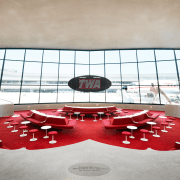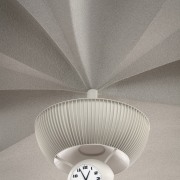Retro flight centre becomes the heart of a luxury new retro hotel at JKF Airport
Half a century ago, JFK’s eye-popping TWA Terminal by master architect Eero Saarinen was a sculptural embodiment of the thrill of the jet age – now it’s been restored and re-celebrated as part of a luxury retro airport hotel
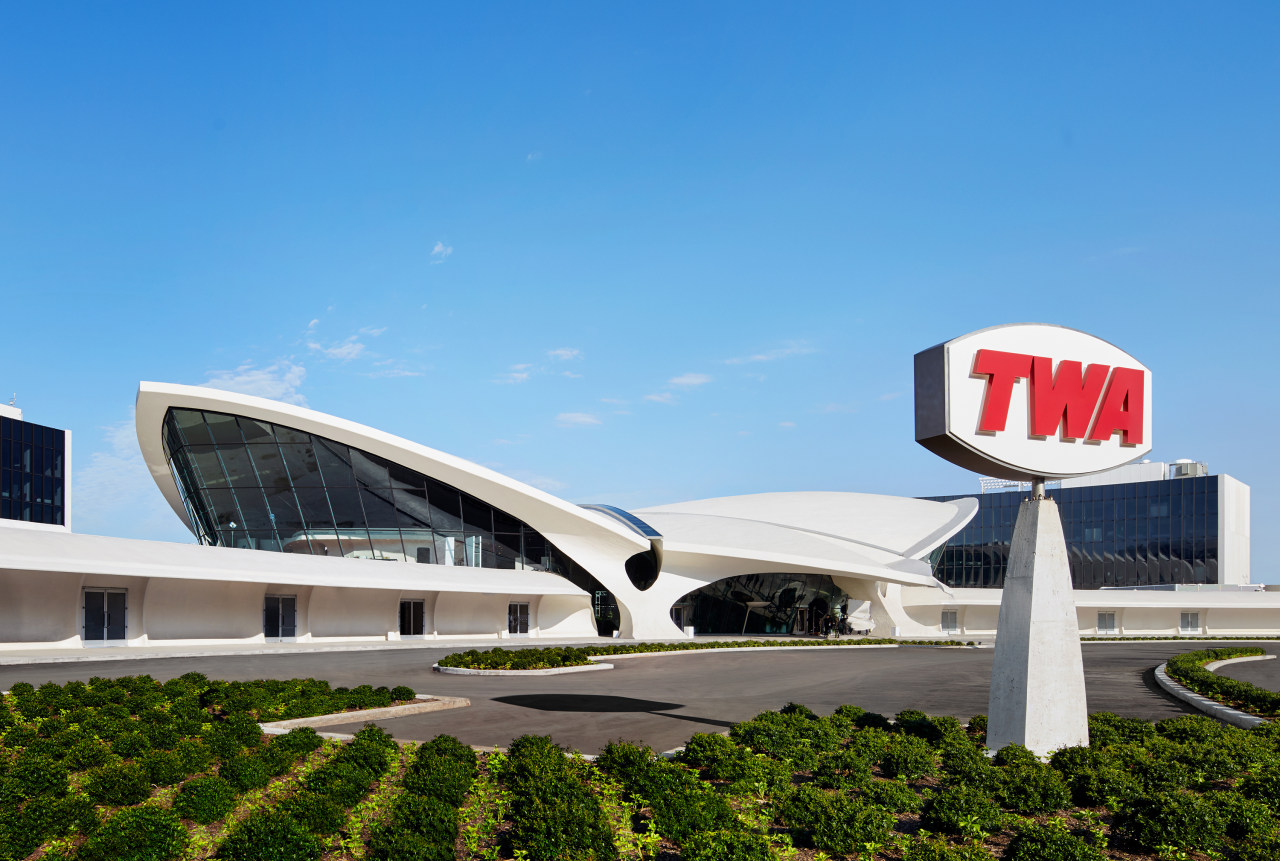
Back in 1962, when architect Eero Saarinen’s fabulously futuristic TWA Flight Center was opened at JFK International Airport, the world was getting pretty darn excited about the golden age of travel. It was true, the times were a-changin’ – in three years a jet would be winging the Fab Four over to the United States from Britain and there was even talk of landing some lucky character on the moon.
In essence, the TWA Flight Center with its fluid, impossible-looking architecture was something of a Mid-century-Modern cathedral to aviation. And the centre had another claim to fame, it was owned briefly by billionaire eccentric Howard Hughes.
The building was designed with a thin four-shell structure – a popular construction form at the time. That aside, other architectural references pale as Saarinen designed the iconic terminal very much on its own terms. Unfortunately, the visionary architect died a year before the terminal actually opened.
The TWA Flight Center served as TWA’s terminal at JFK until 2001, when it was no longer able to support modern aircraft. In 1994 it was designated as a historic landmark and in 2005 it was listed on the New York State Register of Historic Places.
And thus the scene is set for one of the most amazing examples of adaptive reuse in modern times. MCR – the seventh largest US hotel owner-operator – together with Morse Development had the vision to reinvent the terminal as a world-class hotel with 512 guestrooms, a 4650m² state-of-the-art meeting and event space, and a variety of high quality food, beverage and retail options.
Lubrano Ciavarra Architects (LCA) undertook the role of design consultant and design architect, with Beyer Blinder Belle as project architect and preservation architect Stonehill Taylor as interior designer. The events centre was by INC Architecture & Design.
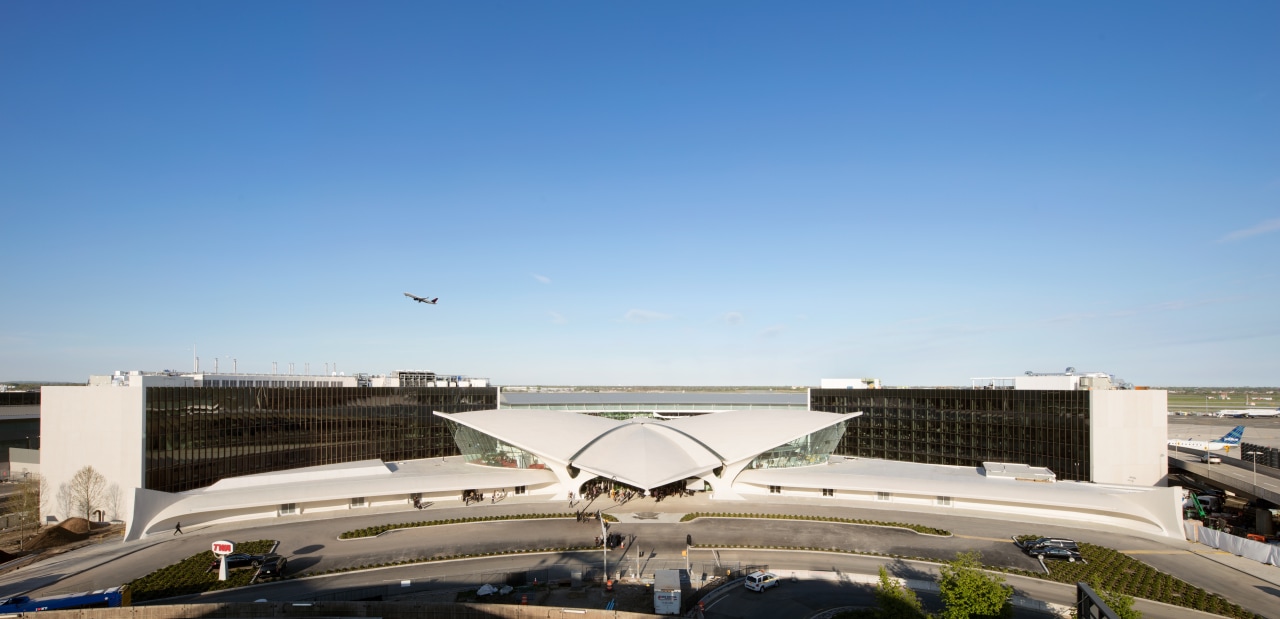
The guest rooms are in two low-rise curved hotel structures set back on either side of the terminal, designed to defer to the historic landmark.
Saarinen’s TWA Flight Center terminal building serves as the hotel lobby, which at 18,500m² is thought to be the largest hotel lobby in the world.
Hotel guests and passengers from every terminal have easy access to the TWA Hotel via the AirTrain as well as through the famous Saarinen passenger tubes that connect directly to JFK’s Terminal 5. These tubes look straight out of James Bond and feature in the DiCaprio movie Catch Me if You Can.
The TWA Hotel also houses a Jet Age and Mid-century-Modern museum that chronicles the design era and the rise of the Jet Age – exhibiting mid-century furniture, TWA uniforms, flight posters and other memorabilia.
Principal at LCA Anne Marie Lubrano says her firm understood the primary goal for the adaptive reuse of the Flight Center to a full-service hotel was the restoration of Saarinen’s masterpiece itself.
“As such, we approached the design of the new hotel components as an opportunity to restore the composition of the overall site,” says Lubrano.
“Our primary understanding of the Flight Center had to be as a sculptural object.”
Saarinen’s sinuous forms – there are no straight lines in the building – obscure the distinction between floor, wall and ceiling, and blur the line between sculpture and architecture. And as with any great artwork, its context or setting is critical.
When the terminal first opened, the Flight Center was surrounded by extensive tarmac and open sky. However, over time, the scene became encumbered by the necessities of a contemporary airport – wrapped by elevated and sunken roadways, pedestrian skywalks, air trains, terminal expansions, parking structures and jet fences.
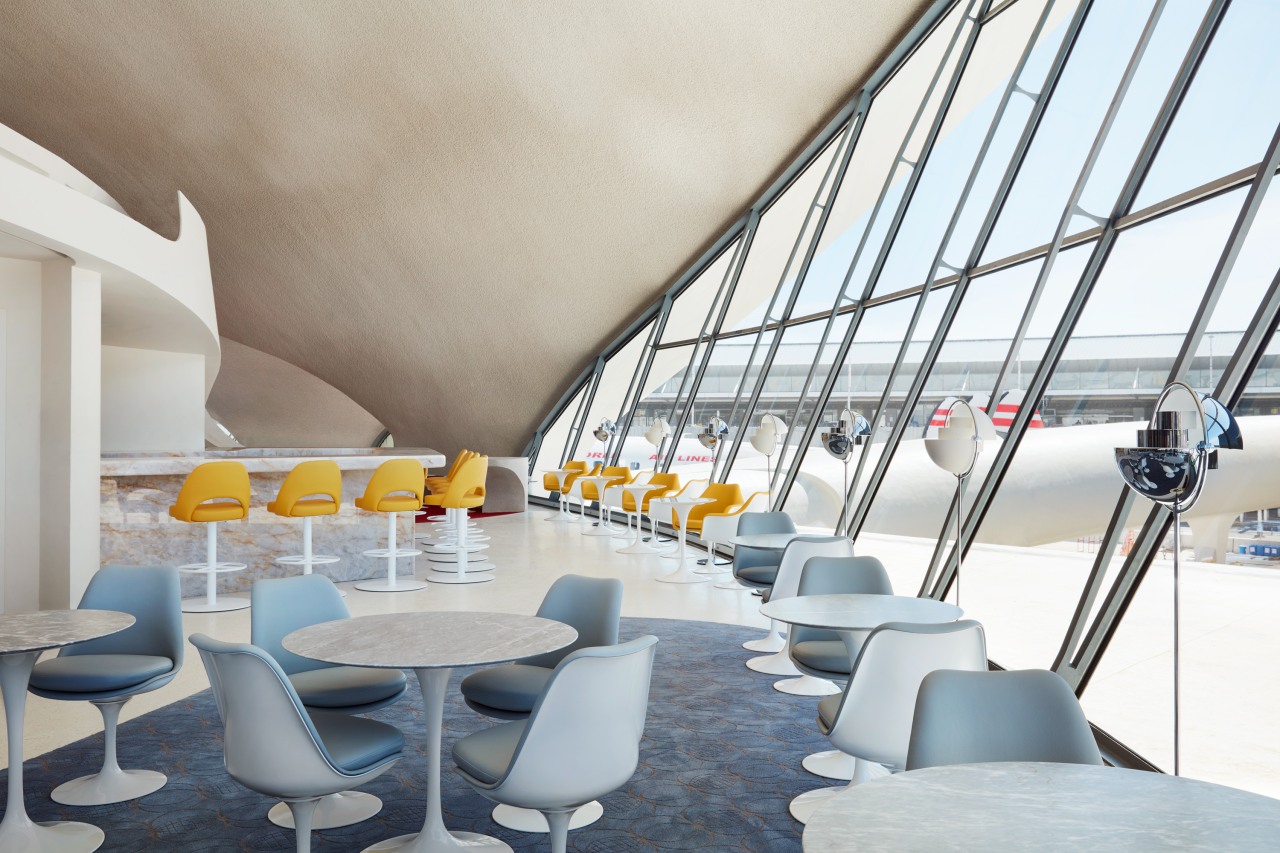
“To restore an uncluttered backdrop, the new hotel facades are considered as continuous vertical glazed surfaces acting as an extension of the sky. And the iconic Flight Centre once again stands out against this constant background.”
In fact, glazing is something of an understatement. The guest rooms in both wings take in the action of one of the busiest airports in the world from behind 18cm-thick, triple glazed, floor-to-ceiling glass. In these spaces a roaring jet engine is just a murmur.
On the roof of one wing there’s an infinity-edge pool and the facility also has a 929m² observation deck and a fitness centre the same size. Eight bars and six restaurants add to the entertainment mix.
The location of the event space was a challenge for LCA – its sheer scale threatened to overwhelm the light touch the firm was trying to maintain.
“It’s as if you want to just shove it underground! And in fact that’s exactly what we did. We created a fabulous events space and reconstructed the tarmac over the top of it,” says Lubrano.
And in turn, another of the hotel’s out-there surprises is parked on that same stretch of tarmac – a gleaming Lockheed Constellation. This is now grounded in its role as a hotel cocktail lounge.
With the original flight centre lovingly restored – with a retro split-flap arrival screen commissioned and touches like the terminal clock retained in their original glory – the new underground conference space and the hotel rooms themselves all take on the same almost flamboyant 1960s design flavour.

The conference room is furnished in the same Chili Pepper Red seen in the original terminal while the feature ceiling is also very much of that time.
The hotel’s ultra-quiet, Sixties-inspired guest rooms feature Saarinen-designed Mid-century Modern Knoll furnishings (the architect had been involved with furniture design early in his career, including pieces made by Knoll), martini bars, vintage rotary phones and gleaming terrazzo-tiled bathrooms with Hollywood-style vanities.
One decidedly modern feature of the hotel is that it is self-powered via an off-grid cogeneration plant.
Tyler Morse, CEO of MCR and Morse Development, says that from the moment guests and visitors arrive at the TWA Hotel, they find themselves immersed in the ethos of 1962’s rich culture, architecture, sights, sounds and ambiance.
“The attention to the smallest details permeates the guest room experience, paying homage to the magnificent landmark and special time in US history.”
Credit list
Project
Project and preservation architect:
Conference and event space interior design:
Landscape architect
Developer
Design consultant and design architect
Hotel rooms; select public area design
Hotel cladding
Story by: Charles Moxham
Photography by: David Mitchell, Christopher Payne
Home kitchen bathroom commercial design
Diving into nature
Personality plus
Classic looks, contemporary efficiency
Commercial Design Trends 35-2C
The world of hotel design is changing, with a move away from bland repetition of a chain’s design template to giving gue...
Read More




